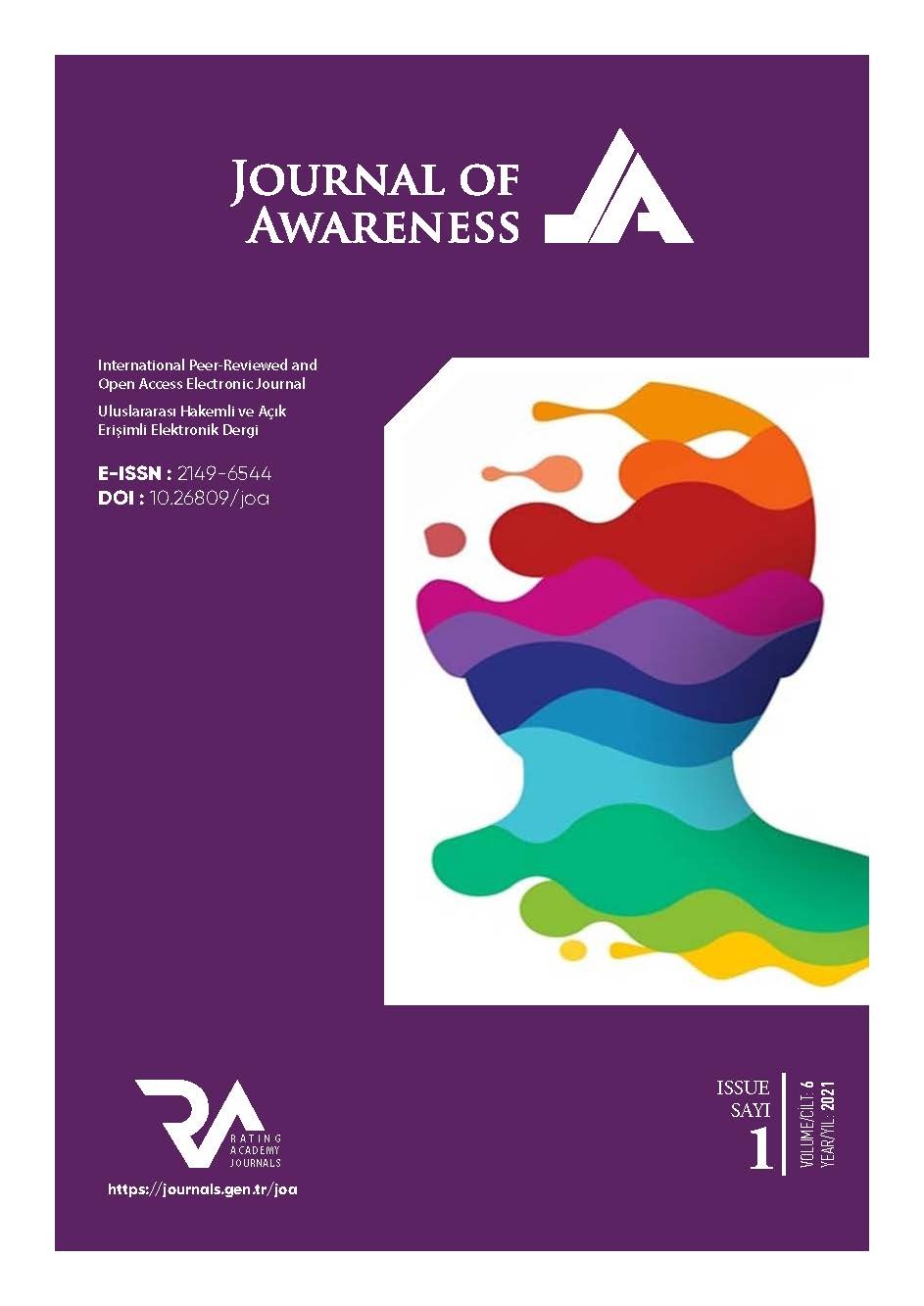PROBLEMATIZING HOME, BELONGING AND IDENTITY IN BINA SHARIF’S MY ANCESTOR’S HOUSE: A TRANSNATIONAL APPROACH
DOI:
https://doi.org/10.26809/joa.6.1.06Anahtar Kelimeler:
Transnationalism- Transmigrant- Migration- Home/Homeland, Identity- Belonging- Trans-Locality- GlobalizationÖzet
Since the 1990s, transnationalism, a as recent field of enquiry, has emerged as another theoretical lens through which we can look into the changing, evolving meanings of home, homeland, and belonging for international migrants. Studies of transnational migrants have focused upon varying aspects of the migrants’ lives: their ties with their kin; laws of naturalization in the host country, involvement in political organizations, the place of cultural iconography such as food, music, tradition in their daily lives. Because these transmigrants neither cut the ties to their countries of origin nor fully assimilate into the new culture of the host country, these immigrants fall under the rubric of transnationals However, transnational studies focusing upon the cross-border lives and activities of transnational subjects ignore the cross-cutting variables of gender, class, age, religion, ideology, period of immigration, citizenship status, different local sending contexts, which play a mediatory role in shaping notions of home, identity, community within even a single transnational community. In order words, it is not possible to talk about the transnationalism of a certain migrant group but of the heterogeneous make-up of transnationalisms, which differ even among the members of a transnational community at any given point in time. To understand the relationship between transnational migrants, and their conceptions of home and belonging, it is of vital importance to explore the specific circumstances of migration and how they influence conceptions of home. Secondly, the celebratory overtones of the transnational conditions of international migrants overlook the negative consequences of transnational lives such as the feelings of loss and dislocation inherent in cross border movements of transmigrants. Reading Pakistani-American Bina Sharif’s play My Ancestor’s House through a transnational lens, I would argue, brings a new insight into the literature on transnationalism by way of highlighting the non-homogenous, non-celebratory, and historically specific aspects of transnationalism in a global age.
İndirmeler
Referanslar
AL-ALİ, NADJE & KHALID KOSER (eds). (2002), New Approaches to Migration? Transnational communities and the transformation of home. London and New York: Routledge.
APPADURAI, A. (1996). Modernity at Large: Cultural Dimensions of Globalization. Minneapolis: University of Minnesota Press.
BASCH, L., N. GLICK SCHILLER & C. SZANTON BLANC (1995), Nations Unbound: Transnational projects, postcolonial predicaments, and deterritorialized nation-states. New York: Gordon and Breach.
BHABBA, H. (1994). The Location of Culture. London: Routledge.
BRAH, A. (1996). Cartographies of Diaspora, London: Routledge.
CLIFFORD, J. (1992). “Travelling Cultures”” in L. Grossberg, C.Nelson, and P. Treichler (eds.) Cultural Studies, London: Routledge, pp.96-111.
CLIFFORD, J. (1997). Routes. Travel and Translation in the Late Twentieth Century. Cambridge,MA: Harvard University Press.
DESAI, J. (2004). Beyond Bollywood: The Cultural Politics of South Asian Diasporic Film, London: Routledge.
GILROY, P. (1993). The Black Atlantic: Modernity and Double Consciousness, Cambridge, MA: Harvard University Press.
GUARNIZO, L.E. & SMITH, M. P. (eds) (1998), Transnationalism from Below. New Brunswick: Transaction Publishers.
HAGGANI, H. (2010). Pakistan. Between Mosque and Military. Washington, D.C.: Carnegie Endowment for International Peace.
HALL, S. (1990), “Cultural Identity and Diaspora” in Rutherford, J. (ed.) Identity: Community, Culture, Difference, London: Lawrence and Wishart, pp.222-237.
HALL, S. (1995), “New Cultures for Old” in D. Massey and P. Jess (eds.) A Place in the World? Places, Cultures, and Globalization, Oxford: Oxford University Press, pp. 175-213.
LEWITT, P. & M. WATERS (2002), Introduction in P. Lewitt and M. Waters (eds.) The Changing Face of Home: The Transnational Lives of the Second Generation, New York: Russell Sage Foundation, pp.1-30.
LEVITT, P., J. DE WIND, & S. VERVOTEC (2003), International Perspectives on Transnational Migration: An Introduction. International Migration Review (37)3 pp.565-75.
MARTIN, BIDDY & CHANDRA TALPADE MOHANTY (1988), “Feminist Politics: What’s Home Got to Do with it?” in de Lauretis, Teresa (ed.) Feminist Studies/Critical Studies London: MacMillan, 191-211.
McLEOD, J. (2007), “‘Between Two Waves’: Caryl Phillips and Black Britain in Moving Worlds”. A Journal of Transcultural Writing 7(1):9-19.
MOSLUND, S.T. (2010). Migration Literature and Hybridity. The Different Speeds of Transcultural Changes England: Palgrave MacMillan.
ONG, A. (1999). Flexible Citizenship: The Cultural Logics of Transnationality, Durham, NC: Duke University Press.
PERKINS, K.A. & UNO, R. (eds). (1996). Contemporary Plays by Women of Color. An Anthology. London, New York: Routledge
SHARIF, B. (1996). My Ancestor’s House in Kathy A. Perkins and Roberto Uno (eds.) Contemporary Plays by Women of Color. An Anthology. London, New York: Routledge, pp.262-279.
SIAM-HENG, MICHAEL HENG, & TEN CHİN LİEW. (eds). (2010), State and Secularism: Perspectives from Asia. Singapore: World Scientific.
SMITH, A. (2004). “Migrancy, Hybridity, and Postcolonial Literary Studies” in Nel Lazarus (ed.) The Cambridge Companion to Postcolonial Literary Studies. Cambridge: Cambridge University Press, pp.241-61.
SMITH, R.C. (1998). Transnational Localities: Community, Technology, and The Politics of Membership within the Context of Mexico and US Migration” in M. P. Smith and L. E. Guernizo (eds) Transnationalism from Below, New Brunswick, NJ: Transaction Publishers, pp.196-238
WERBNER, P. (1989). The Migration Process: Capital, gifts and offerings among British Pakistanis. Explorations in Anthropology Series, Oxford: Berg.
İndir
Yayınlanmış
Nasıl Atıf Yapılır
Sayı
Bölüm
Lisans
Telif Hakkı (c) 2021 Holistence Publications

Bu çalışma Creative Commons Attribution 4.0 International License ile lisanslanmıştır.
Yazarlar, makale Journal of Awareness’de yayınlanmak üzere kabul edildiğinde.makalenin içeriğindeki tüm telif haklarını, Rating Academy Ar-Ge Yazılım Yayıncılık Eğitim Danışmanlık ve Organizasyon Ticaret Ltd. Şti’ne devrederler. Yazarlar, patent hakları gibi telif hakkı dışındaki tüm mülkiyet haklarını saklı tutar.
Bu makalede yazar olarak listelenen herkes çalışmaya önemli, doğrudan, entelektüel katkılar yapmış olmalı ve bunun için kamu sorumluluğu almalıdır.
Bu makale daha once yayınlanmamış ve başka dergilerde yayınlanmak üzere gönderilmemiştir.










